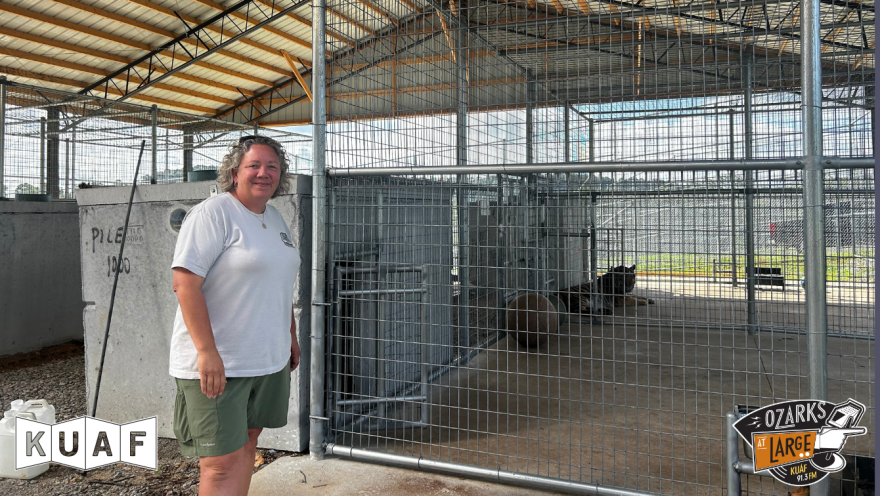Picture this: Your whole life has been spent in a cage. You were ripped away from your mother as an infant and forced to behave as a spectacle while onlookers jeered at you through the wire of a chain link fence.
That was Dutchess’ reality for most of her life. Dutchess is a tiger who was kept at a roadside zoo in Ohio. Now, she calls the Ozark mountains home. But how did she get here?

That was Dutchess– She sounds pretty comfortable, but it took time, effort and care to get her that way.
Her story begins in Perrysburg, Ohio, at Tigerridge Exotics, a facility on the side of a highway that held one lion, six tigers, one black leopard, one liger, one cougar, and one Kodiak bear. The owner, Kenny Hetrick, refused to comply with Ohio state regulations, like providing adequate vet care or supplying his animals with proper diets and clean water. Eventually, The Ohio Department of Agriculture seized Hetrick’s animals and dispersed them to qualified rescue facilities.
That’s how Dutchess ended up at Big Cat Rescue in 2015. That name might sound familiar to anyone who watched the Netflix docuseries Tiger King, as the facility was run by Carol Baskin. The anchors at FOX 35 Orlando can tell you the story from here:
FOX 35: “Tiger King took the nation by storm during the pandemic and featured Florida's on Big Cat Rescue, whose owner, of course, Carole Baskin, became a household name, but soon it will close its doors. This all comes down to Big Cat Rescue accomplishing its own goal of putting themselves out of business so there wouldn't be a need for them anymore. So, think back to last year that's when Congress passed into law the Big Cat Public Safety Act.”
The Big Cat Public Safety Act was enacted in late 2022. According to the U.S. Fish and Wildlife Service, its purpose is to end the private ownership of big cats as pets and prohibit exhibitors from allowing public contact with big cats, including cubs. It also placed new restrictions on the commerce, breeding, possession, and use of certain big cat species, like lions and tigers.
Baskin and her husband, Howard, worked with other advocates to pass the legislation through the House and Senate. Some of the most influential help came from Eureka Springs’ Turpentine Creek Wildlife Refuge and Congressman Steve Womack, who cosponsored the bill.
Emily McCormack is Turpentine Creek’s animal curator. She said Turpentine Creek and Big Cat Rescue are both accredited Global Federation of Animal Sanctuaries facilities and founding members of the Big Cat Sanctuary Alliance.
They knew the passing of the Big Cat Public Safety Act would result in a surge of large predators needing new homes, and when Baskin decided to shut down Big Cat Rescue, she looked to Turpentine Creek to be the future home for the animals in her care.
“And they decided to go a different direction, funding-wise, and asked us to take their 33 remaining cats that they had at their facility and bring them here,” McCormack said. “And it just so happens that we were in the process of this massive capital campaign to build a new education center.”
That money would eventually fund Freedom Field: A $4 million, 14-acre space with 44 new enclosures for Turpentine Creek’s rescued animals. All 33 cats from Big Cat Rescue now live at Freedom Field. Those new inhabitants include bobcats, caracals, servals, Savannah cats, and, of course, tigers, like Dutchess.
McCormack designed Freedom Field, but she isn’t an architect– she’s a zoologist.
“But art and drawing was always one of my things since I was a kid,” McCormack said. “And so, yeah, I don't know. I can just picture things and then draw it. To map it all out I like, literally worked with my staff, and I would just send them, ‘Hey, walk 90 feet that way, with this wheel,’ and then I just would look at things. And every time this fence turns the perimeter and the habitats, we dropped a flag there, and I used Google Earth.”
JT: It looks pretty good, are you pleased?
“I am. I don't think there's much that we could do different. I think, you know, there was a lot more financially that went into the plan. You have this plan, and, you know, I just saw this, but I didn't realize, so, I'm not an engineer, how much dirt had to be brought in, you know? So, our costs went way above what we originally thought, and this is over a $4 million project, and we're still fundraising for it.”

In addition to Freedom Field, McCormack said they still aim to break ground on a museum and education center by 2026.
Turpentine Creek has been an educational place since its inception more than 30 years ago. Education Coordinator Shayleen Richert said that teaching people about what the refuge does can draw a range of reactions.
“Some people love what we're doing, then we also get some people who don't like what we're doing,” Richert said. “I mean, it's just one of those things that it's a toss-up in the air of who you're going to get in contact with because we're getting animals from people who loved having those animals at those other places. So we have gotten a lot of people who, when we go and rescue them, they don't like that we're rescuing these animals from these places because they think that they're fine at those other places, or they don't actually get to see the behind-the-scenes of what these animals are being treated like.”
Turpentine Creek’s promotions coordinator, Cheryl King, said big cats like tigers and lions aren’t the only wild animals that need our help. Private wild cat ownership is almost a fad, and the behind-the-scenes of someone owning a bobcat or serval can be just as bad as a tiger’s.
“People don't know,” King said. “They don't understand. They don't realize, and everything that's needed to properly care. It's not like you can take this animal home and give them cat food. You know, they can't live off of that. They're obligate carnivores. They need real meat. They need a whole chicken. You don't realize the burden you're taking on, even with these small cats, and they're still inappropriate for your home.”
Jack Travis: And it seems like it's becoming an even worse problem. You see these videos on Instagram of people that have Caracals in their houses, in their living rooms, and it's like there's no way that can be safe, for anyone.
“Not safe,” King said. “It's not safe for the animal. It's not safe for the owners. We just recently brought in Emma. Emma was living in a basement. She's a African caracal had been living in a basement for two years, never got outside, never saw sunlight, never felt grass, for two years living in the basement. The woman was good-hearted. She meant well but very quickly realized that this animal was beyond her means to control and care for.”

Funding an educational center would allow Turpentine Creek to spread vital information on the Big Cat and Small Exotic Cat crises and how people can help these animals in the wild, too. More information on how you can help Turpentine Creek rescue cats—like Dutchess— can be found on their website.
Ozarks at Large transcripts are created on a rush deadline. This text may not be in its final form and may be updated or revised in the future. The authoritative record of KUAF programming is the audio record.








